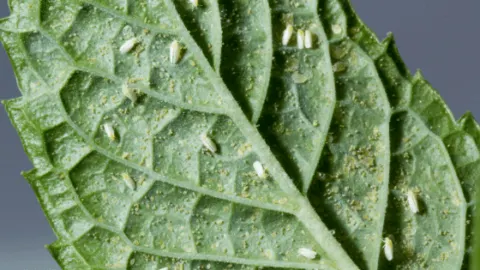Meet the smallest “fly” you’ll ever see (or not see) in your lifetime. It’s the whitefly.
Sometimes the only way to even know these pests are living on a plant is when the infestation has gotten large.
And that’s only because of the giant cloud of whiteflies you’ll see hovering over your plant after you’ve shaken a leaf. Within twenty seconds, they’ll settle right down.
These buggers come out to play during the hottest months, from June to the end of August.
Since whiteflies feed off of the sap from your plant, they can do some damage. And the more whiteflies there are, the more harm they’ll create for your plant.
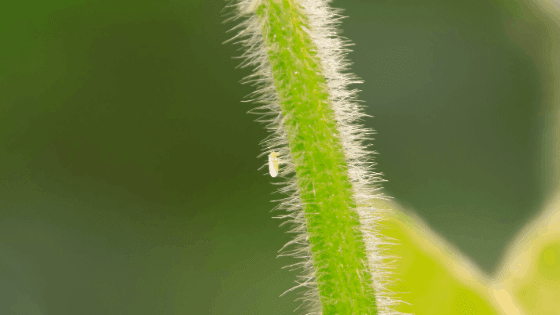
A whitefly on a plant petiole
Worst of all, whiteflies transmit plant viruses when they feed.
There’s the possibility of whiteflies leading to the death of your favorite plant.
The kicker of it all is that whiteflies are a pain to get rid of. You can’t do a one-time treatment and walk away.
You’re going to have to fight if you want rid of the whiteflies. And if you want your plant healthy.
We’re here to help you get rid of these pests and to prevent them in the future.
This is our guide on whiteflies and everything you need to know about them.
Other plant pests that we wrote extensive articles about are:
Brown Scale – Best way how to get rid of them
Aphids – How to deal with an aphid infestation
Table of Contents

Whiteflies on plants
What are Whiteflies?
Whiteflies come from the bug family Aleyrodidae. Aleyrodidae is the only family in the superfamily Aleyrodoidea. They have a close relation to both aphids and mealybugs.
There are around 1500 species of whiteflies in the world.
The most common whitefly species include:
- Bandedwing whitefly
- Giant whitefly
- Greenhouse whitefly
- Iris whitefly
- Silverleaf whitefly
- Sweetpotato whitefly
On average, adult whiteflies grow to 1/16 to 1/10 of an inch in length. Their wingspan is around three millimeters in length. They’re not very big at all.
They are soft-bodied and triangular. They have white wings that have a powdery appearance. This powdery appearance is from a fine wax powder.
Their legs are long and they have short antennas. Female whiteflies are bigger than male whiteflies.
Adults are most active during the day. Unlike a lot of plant pests, they’re not nocturnal.
The nymphs start wingless. They are oval, flat, and transparent. As nymphs feed, they seem almost camouflaged with the color of the leaf.
Neither adult nor nymph has a dormant stage for surviving freezing temperatures.
Each whitefly species has an attraction to a different kind of plant. Most are named after the plant they’re most attracted to.
But most whitefly species prefer various veggie plants. They also like flowers such as chrysanthemums, fuchsias, geraniums, mums, roses, and poinsettias.
How Whiteflies Reproduce
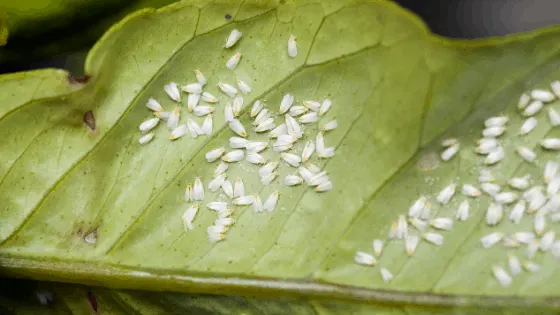
Whitefly infestation
Around April, female whiteflies start laying anywhere from 200 to 500 eggs.
They don’t need a male to reproduce which allows them to produce several generations in a year.
The females lay their eggs in a circular cluster underneath the leaves of their host plant.
Whitefly eggs are yellow when first laid and oblong. As they get closer to hatching, the darker brown they become.
It takes about 10 days for the eggs to hatch at 65F (18C) to 75F (24C). When they do hatch, the nymphs crawl away from their eggs.
They don’t get very far, only a few millimeters. But they find a place to flatten themselves against and feed.
In the meantime, they lose their ability to crawl or walk until they grow into adults.
Nymphs go through four stages before they reach adulthood. The growth speeds up in hotter temperatures.
It takes about two to four days after a female has reached the pupal stage for her to start laying eggs.
Starting from the egg stage, it takes a whitefly about 35 days to develop into an adult. Adults live up to two months.
How Whiteflies Attack Your Plant
Whiteflies act as most indoor plant pests do. They live for the sap inside of a plant.
Bugs who live off of sap are called Hempitera.
The sap contains all the nutrients and water the plant has absorbed. Whiteflies suck the sap out of a plant through the veins of the leaves or the stem.
Their mouths are similar to a needle for this very purpose.
Nutrients and hydration are what make plants thrive. And these bugs can steal that from your plant.
They’re stealing both from the plant’s phloem sieve tube and xylem cells.
The phloem sieve tube carries the nutrients throughout a plant. And the xylem cells carry the water absorbed from a plant’s soil.
There are several ways this will affect your plant. One of the biggest ways being preventing photosynthesis.
Photosynthesis is the process of a plant absorbing energy from the sun (solar energy). The plant turns the absorbed energy into chemical energy.
Your plant hangs onto this chemical energy so it can use it in the future.
Plants rely on photosynthesis to live just as much as they rely on nutrients and water. Without the energy this process provides, it fails at thriving.
Another issue with whiteflies feeding off your plant lies in their toxic saliva. The toxins lower turgor pressure. Turgor pressure refers to the force inside a cell.
Turgor pressure means the force is pushing the plasma membrane against (or away from) the cell’s walls.
A plant with high turgor pressure causes the cell walls to expand. This helps the plant grow.
So, when the turgor pressure is low, the opposite is happening. The walls are coming in instead of out. The plant starts to shrink and wilt.
Another issue that arises with whiteflies is that they transmit viruses. They can transmit over 100 different types.
When a whitefly feeds off an infected plant, it picks up the virus it’s carrying.
That whitefly may migrate to another plant for sustenance. When it feeds on the new plant, it’s saliva spreads that virus.
The sweetpotato whitefly carries the majority of virus transmissions from plant to plant.
Each type of plant is susceptible to different viruses. And each virus might look different in different plants.
How to Prevent Whiteflies
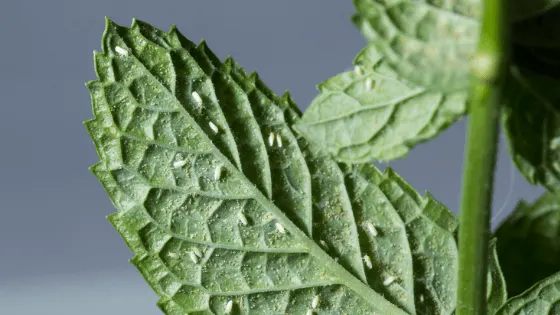
Whiteflies settling on the underside of a leaf
It’s easier to prevent whiteflies than it is to get rid of them. There are several ways to prevent these pests.
Dehydrated plants become stressed. If your plant is not getting the hydration it needs, it’s more susceptible to plant pests and diseases.
Keep your plants watered to prevent dry, dehydrated plants.
Don’t over-fertilize your plant, particularly with fertilizers that are full of nitrogen.
It creates a large amount of nitrogen in your plants, not only the soil. Nitrogen attracts whiteflies.
Always check plants for pests before you bring them into your home.
When one plant happens to have whiteflies, it doesn’t take much for them to fly over to another one.
Check your plants every day for any pests. Make sure you check every nook and cranny too.
If you see any whiteflies, get rid of them straight away. They breed fast. A small infestation can turn into a large infestation in a blink of an eye.
How to Get Rid of Whiteflies
Detecting Whiteflies
Before you treat your plant for whiteflies, you want to ensure it has a bug problem.
There are a lot of other plant pests and conditions that can cause very similar red flags.
You can find whiteflies under the leaves of your plant. Look for them on the veins. There will be a bunch of tiny white and winged bugs hanging out.
Even though they’re super small, you won’t miss them. As soon as you flip that leaf around, they’ll fly off of the plant in a clustered cloud.
They also gravitate toward the top of plants or the end of the stem.
Black sooty mold is a sign of whiteflies or other sap-suckers. When the whiteflies feed on a plant, they excrete a sweet honeydew residue.
It’s a sticky substance made from undigested sugars. It doesn’t take long for the substance to create the sooty mold.
The spores start to spread over the plant and create more moldy spots.
Since the whiteflies are stealing the nutrients from the plant, it can’t do what it needs to do to thrive.
It becomes unable to absorb water from the soil. So, it can’t develop the strong roots it needs to grow. This results in stunted growth for a plant.
The leaves will start to wilt or even curl. They might turn yellow and start falling off the plant.
Small Whitefly Infestations
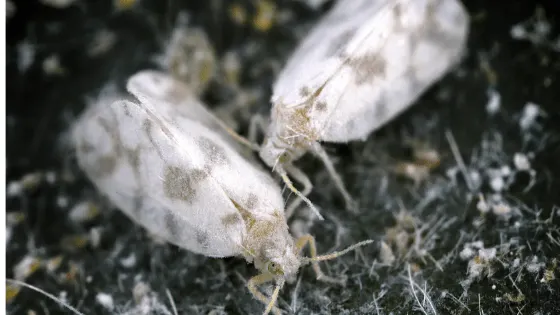
Whitefly closeup
There are different methods you can use to get rid of a small whitefly infestation. Most of these methods don’t take a lot of work.
One method is to use yellow sticky traps. These sticky traps stop the whiteflies before they can even land on your plant.
Place these sticky traps sticky side up. You’re going to need quite a few of them if you want to get every whitefly you can.
It’ll also grab any current whiteflies on your plant when they decided to fly or hover. Making it a great method for small infestations.
If there are little whiteflies and eggs, you can prune the infested leaves and branches.
But if you go this route you have to put the clippings into a sealed bag and take them outside right away.
The University of California suggests using a syringe filled with water under the leaves.
This makes sure you hit the whiteflies with the water directly.
The university found in studies that it works better than chemicals on whiteflies.
When you only find a handful of bugs swarming your plant, the easiest way to get rid of them is with a hose.
You blast your plant with a powerful force of water. As long as your plant is strong enough to handle it, of course.
This big push of water makes the whiteflies scatter and take off. The eggs will fly off the plant.
Neem oil is another common method for small infestations of whiteflies. It’s a natural extract from the neem tree. It’s non-toxic and safe for your plant.
It won’t only kill the whiteflies but the eggs as well.
You have to mix neem oil with water in a spray bottle. Spray every inch of the plant with the oil.
Direct contact will smother the whiteflies so they can’t get oxygen.
You’ll want to spray your plant once a week until you’re 100% sure that all the whiteflies and eggs are gone.
Large Whitefly Infestations
Whiteflies are notorious for being an annoyance. You get rid of them once (or you think you do) only to find more of them a week later.
So, when you encounter a large infestation you have to jump through some hurdles.
The first option to try for a large infestation is insecticidal soap. It’s perfect for soft-bodied and small bugs. Whiteflies hit both these categories.
As soon as this soap makes contact with whitefly or their eggs, they die. It accomplishes this by washing away the protective coating on them.
Inside the whitefly, the soap breaks down the cell membrane. This results in the cell dying or the whitefly dying by suffocation.
You always want to test insecticidal soap before you spray your whole plant down with it.
Some plants are sensitive to the soap. Some of these plants are:
- Crown of thorns
- Easter lily
- Ferns
- Gardenia
- Violets
Apply in the morning or at night. The pests are slower in the cold so you’re more likely to get them with the soap.
You’ll need to spray the plant at least once a week for a month. Or until all the whiteflies and eggs are gone from the plant.
Our favorite method involves garlic spray to ward off whiteflies and other pests.
Sulfur is a major mineral found in garlic. And there are two ways that sulfur harms whiteflies.
First, the mineral is toxic to whiteflies and many other plant pests.
Second, it breaks down the protective coating around the bugs’ exoskeleton. Without this coating, they dehydrate and die.
Plus, sulfur also works as an anti-fungal. If your plant has sooty mold, you’re treating both the mold and the whiteflies.
To make garlic spray you’ll need:
- 1/4 cup of dish detergent or dish soap
- 2 teaspoons of cayenne pepper
- 4 cloves of garlic
- 35 ounces (1 liter) of water
- Pot
- Spray bottle
First, you have to mash up all four cloves of garlic. In a large pot, add the mashed garlic, cayenne pepper, and water.
Stir everything and bring the water to a boil. Pour everything into a container and let it sit overnight on your counter.
The next day, fill the spray bottle with the cayenne pepper, mashed garlic, and water. Add the dish detergent to the bottle and mix everything up.
Now you can spray your plant. Cover the entire plant, including the base of the stem and under the leaves.
Spray the plant every other day until you know the bugs are all gone.
There’s another concoction that has been effective for many indoor houseplants. You can make this recipe at home.
You’ll need:
- 1 cup of 70% isopropyl alcohol
- 2 tablespoons of dish detergent or liquid dish soap
- 4 cups of water
- Spray bottle
Pour the cup of isopropyl alcohol and four cups of water into the spray bottle. Shake the bottle to mix them well.
Next, you add two tablespoons of dish detergent to the spray bottle. You’re going to mix it up.
Some dish detergents and liquid dish soaps are heavy. So, if shaking the bottle doesn’t mix it, try mixing with a spoon.
Before you apply this special mix, test it on the leaf of your plant. Come back in a day to see if it had any bad effects. A healthy plant is a good sign to go ahead with using the mix.
Space your plant out so when you spray, it’ll reach every inch easier.
Spray the infested areas of the plant. If you’re not sure where that is, feel free to spray the entire plant.
You’ll need to spray your plant once a week for at least a month. Keep treating it until you’re positive there are no bugs left.
When none of the above works, don’t give up quite yet. You can vacuum up the whiteflies. We’re serious.
You can take a hand-held vacuum to your plant to suck up all the whiteflies and eggs. Keep the vacuum far enough away that it doesn’t do damage to the plant.
You’ll need to do this process a few days in a row.
You should do this early in the morning. When it’s cold like it is in the morning, the whiteflies move slowly.
After you’ve vacuumed the bugs, immediately empty the vacuum bag into a sealed plastic bag.
Take the plastic bag outside right away so the whiteflies don’t find their way back to your plant.
You want to repeat this for a few weeks to make sure you got everything.
When all else fails, you’ll have to get rid of the infected plant. You don’t want to infect any other plants nor do you want those pests flying around your home.
Whitefly Frequently Asked Questions
Is the whitefly really a fly?
No, whiteflies aren’t actual flies. They come from two different insect families. They’re called whiteflies because they have a waxy film over their wings.
Why aren’t chemical pesticides getting rid of my plant’s whitefly infestation?
Chemical pesticides aren’t going to work. Whiteflies are resistant to treatments because they’ve been used over the decades. Or they develop resistance quickly.
Do whiteflies bite at all?
Whiteflies are only dangerous for plants. They’re annoying creatures but they’re harmless. Whiteflies don’t bite people or animals at all.
Conclusion
Whiteflies seem innocent when you first find them on your plant. But they’re far from innocent. They’re a big nuisance when it comes down to it.
Despite how rough they can be, you can get rid of them with our tried and true methods. We suggest you try the garlic spray first for any large infestations.

